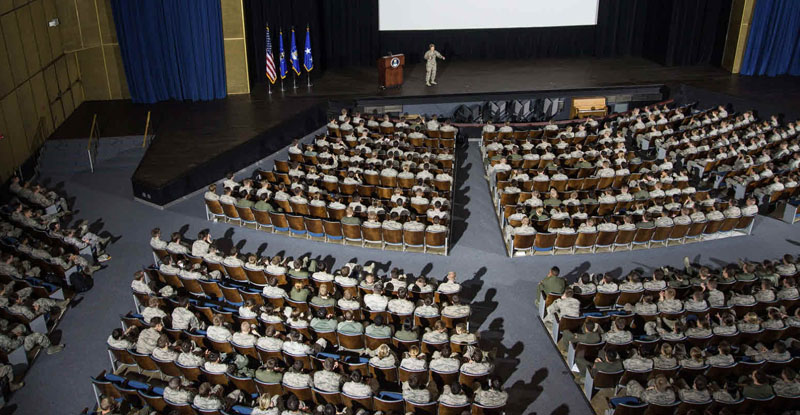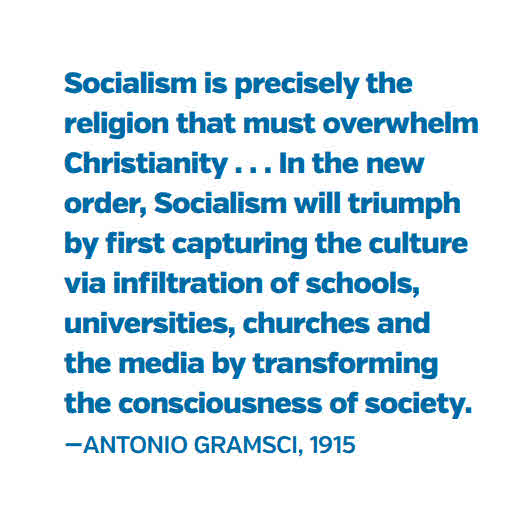Would that every academy cadet and military servicemember know this information and how America has been deliberately manipulated by political warfare:
By William Lind
Sometime during the last half-century, someone stole our culture. Just 50 years ago, in the 1950s, America was a great place. It was safe. It was decent. Children got good educations in the public schools. Even blue-collar fathers brought home middle-class incomes, so moms could stay home with the kids. Television shows reflected sound, traditional values.
Where did it all go? How did that America become the sleazy, decadent place we live in today – so different that those who grew up prior to the ’60s feel like it’s a foreign country? Did it just “happen”?
It didn’t just “happen.” In fact, a deliberate agenda was followed to steal our culture and leave a new and very different one in its place. The story of how and why is one of the most important parts of our nation’s history – and it is a story almost no one knows. The people behind it wanted it that way.
What happened, in short, is that America’s traditional culture, which had grown up over generations from our Western, Judeo-Christian roots, was swept aside by an ideology. We know that ideology best as “political correctness” or “multi-culturalism.” It really is cultural Marxism, Marxism translated from economic into cultural terms in an effort that goes back not to the 1960s, but to World War I.
The end goal of Marxism is destruction.
Incredible as it may seem, just as the old economic Marxism of the Soviet Union has faded away, a new cultural Marxism has become the ruling ideology of America’s elites. The No. 1 goal of that cultural Marxism, since its creation, has been the destruction of Western culture and the Christian religion.
To understand anything, we have to know its history. To understand who stole our culture, we need to take a look at the history of “political correctness.”
Early Marxist theory
Before World War I, Marxist theory said that if Europe ever erupted in war, the working classes in every European country would rise in revolt, overthrow their governments and create a new Communist Europe. But when war broke out in the summer of 1914, that didn’t happen.
Instead, the workers in every European country lined up by the millions to fight their country’s enemies. Finally, in 1917, a Communist revolution did occur, in Russia. But attempts to spread that revolution to other countries failed because the workers did not support it.
After World War I ended in 1918, Marxist theorists had to ask themselves the question: What went wrong?
As good Marxists, they could not admit Marxist theory had been incorrect. Instead, two leading Marxist intellectuals, Antonio Gramsci in Italy and Georg Lukacs in Hungary (Lukacs was considered the most brilliant Marxist thinker since Marx himself) independently came up with the same answer.
They said that Western culture and the Christian religion had so blinded the working class to its true, Marxist class interests, that a Communist revolution was impossible in the West, until both could be destroyed. That objective, established as cultural Marxism’s goal right at the beginning, has never changed.
A new strategy
Gramsci famously laid out a strategy for destroying Christianity and Western culture, one that has proven all too successful. Instead of calling for a Communist revolution up front, as in Russia, he said Marxists in the West should take political power last, after a “long march through the institutions” – the schools, the media, even the churches, every institution that could influence the culture.
That “long march through the institutions” is what America has experienced, especially since the 1960s. Fortunately, Mussolini recognized the danger Gramsci posed and jailed him. His influence remained small until the 1960s, when his works, especially the “Prison Notebooks,” were rediscovered.
Georg Lukacs proved more influential. In 1918, he became deputy commissar for culture in the short-lived Bela Kun Bolshevik regime in Hungary. There, asking, “Who will save us from Western civilization?” he instituted what he called “cultural terrorism.” One of its main components was introducing sex education into Hungarian schools. Lukacs realized that if he could destroy the country’s traditional sexual morals, he would have taken a giant step toward destroying its traditional culture and Christian faith.
Far from rallying to Lukacs’ “cultural terrorism,” the Hungarian working class was so outraged by it that when Romania invaded Hungary, the workers would not fight for the Bela Kun government, and it fell. Lukacs disappeared, but not for long. In 1923, he turned up at a “Marxist Study Week” in Germany, a program sponsored by a young Marxist named Felix Weil who had inherited millions. Weil and the others who attended that study week were fascinated by Lukacs’ cultural perspective on Marxism.
The Frankfurt School
Weil responded by using some of his money to set up a new think tank at Frankfurt University in Frankfurt, Germany. Originally it was to be called the “Institute for Marxism.” But the cultural Marxists realized they could be far more effective if they concealed their real nature and objectives. They convinced Weil to give the new institute a neutral-sounding name, the “Institute for Social Research.”
Soon known simply as the “Frankfurt School,” the Institute for Social Research would become the place where political correctness, as we now know it, was developed. The basic answer to the question “Who stole our culture?” is the cultural Marxists of the Frankfurt School.
At first, the Institute worked mainly on conventional Marxist issues such as the labor movement. But in 1930, that changed dramatically. That year, the Institute was taken over by a new director, a brilliant young Marxist intellectual named Max Horkheimer. Horkheimer had been strongly influenced by Georg Lukacs. He immediately set to work to turn the Frankfurt School into the place where Lukacs’ pioneering work on cultural Marxism could be developed further into a full-blown ideology.
To that end, he brought some new members into the Frankfurt School. Perhaps the most important was Theodor Adorno, who would become Horkheimer’s most creative collaborator. Other new members included two psychologists, Eric Fromm and Wilhelm Reich, who were noted promoters of feminism and matriarchy, and a young graduate student named Herbert Marcuse.
Advances in cultural Marxism
With the help of this new blood, Horkheimer made three major advances in the development of cultural Marxism. First, he broke with Marx’s view that culture was merely part of society’s “superstructure,” which was determined by economic factors. He said that on the contrary, culture was an independent and very important factor in shaping a society.
Second, again contrary to Marx, he announced that in the future, the working class would not be the agent of revolution. He left open the question of who would play that role – a question Marcuse answered in the 1950s.
Third, Horkheimer and the other Frankfurt School members decided that the key to destroying Western culture was to cross Marx with Freud. They argued that just as workers were oppressed under capitalism, so under Western culture, everyone lived in a constant state of psychological repression. “Liberating” everyone from that repression became one of cultural Marxism’s main goals. Even more important, they realized that psychology offered them a far more powerful tool than philosophy for destroying Western culture: psychological conditioning.
Today, when Hollywood’s cultural Marxists want to “normalize” something like homosexuality (thus “liberating” us from “repression”), they put on television show after television show where the only normal-seeming white male is a homosexual.
That is how psychological conditioning works; people absorb the lessons the cultural Marxists want them to learn without even knowing they are being taught.
The Frankfurt School was well on the way to creating political correctness. Then suddenly, fate intervened. In 1933, Adolf Hitler and the Nazi Party came to power in Germany, where the Frankfurt School was located. Since the Frankfurt School was Marxist, and the Nazis hated Marxism, and since almost all its members were Jewish, it decided to leave Germany.
In 1934, the Frankfurt School, including its leading members from Germany, was re-established in New York City with help from Columbia University. Soon, its focus shifted from destroying traditional Western culture in Germany to doing so in the United States. It would prove all too successful.
New developments
Taking advantage of American hospitality, the Frankfurt School soon resumed its intellectual work to create cultural Marxism. To its earlier achievements in Germany, it added these new developments.
Critical Theory
To serve its purpose of “negating” Western culture, the Frankfurt School developed a powerful tool it called “Critical Theory.”
What was the theory? The theory was to criticize. By subjecting every traditional institution, starting with family, to endless, unremitting criticism (the Frankfurt School was careful never to define what it was for, only what it was against), it hoped to bring them down.
Critical Theory is the basis for the “studies” departments that now inhabit American colleges and universities. Not surprisingly, those departments are the home turf of academic political correctness.
Studies in prejudice
The Frankfurt School sought to define traditional attitudes on every issue as “prejudice” in a series of academic studies that culminated in Adorno’s immensely influential book, “The Authoritarian Personality,” published in 1950. They invented a bogus “F-scale” that purported to tie traditional beliefs on sexual morals, relations between men and women and questions touching on the family to support for fascism. Today, the favorite term the politically correct use for anyone who disagrees with them is “fascist.”
Domination
The Frankfurt School again departed from orthodox Marxism, which argued that all of history was determined by who owned the means of production. Instead, they said history was determined by which groups, defined as men, women, races, religions, etc., had power or “dominance” over other groups.
Certain groups, especially white males, were labeled “oppressors,” while other groups were defined as “victims.” Victims were automatically good, oppressors bad, just by what group they came from, regardless of individual behavior.
Though Marxists, the members of the Frankfurt School also drew from Nietzsche (someone else they admired for his defiance of traditional morals was the Marquis de Sade). They incorporated into their cultural Marxism what Nietzsche called the “transvaluation of all values.”
What that means, in plain English, is that all the old sins become virtues, and all the old virtues become sins. Homosexuality is a fine and good thing, but anyone who thinks men and women should have different social roles is an evil “fascist.”
That is what political correctness now teaches children in public schools all across America. The Frankfurt School wrote about American public education. It said it did not matter if school children learned any skills or any facts. All that mattered was that they graduate from the schools with the right “attitudes” on certain questions.
Media and entertainment
Led by Adorno, the Frankfurt School initially opposed the culture industry, which they thought “commodified” culture. Then, they started to listen to Walter Benjamin, a close friend of Horkheimer and Adorno, who argued that cultural Marxism could make powerful use of tools like radio, film and later television to psychologically condition the public.
Benjamin’s view prevailed, and Horkheimer and Adorno spent the World War II years in Hollywood. It is no accident that the entertainment industry is now cultural Marxism’s most powerful weapon.
The growth of Marxism in the United States
After World War II and the defeat of the Nazis, Horkheimer, Adorno and most of the other members of the Frankfurt School returned to Germany, where the Institute re-established itself in Frankfurt with the help of the American occupation authorities. Cultural Marxism in time became the unofficial but all-pervasive ideology of the Federal Republic of Germany.
But hell had not forgotten the United States.
Herbert Marcuse remained here, and he set about translating the very difficult academic writings of other members of the Frankfurt School into simpler terms Americans could easily grasp. His book “Eros and Civilization” used the Frankfurt School’s crossing of Marx with Freud to argue that if we would only “liberate non-procreative eros” through “polymorphous perversity,” we could create a new paradise where there would be only play and no work. “Eros and Civilization” became one of the main texts of the New Left in the 1960s.
Marcuse also widened the Frankfurt School’s intellectual work. In the early 1930s, Horkheimer had left open the question of who would replace the working class as the agent of Marxist revolution. In the 1950s, Marcuse answered the question, saying it would be a coalition of students, blacks, feminist women and homosexuals – the core of the student rebellion of the 1960s, and the sacred “victims groups” of political correctness today.
Marcuse further took one of political correctness’s favorite words, “tolerance,” and gave it a new meaning. He defined “liberating tolerance” as tolerance for all ideas and movements coming from the left, and intolerance for all ideas and movements coming from the right.
When you hear the cultural Marxists today call for “tolerance,” they mean Marcuse’s “liberating tolerance” (just as when they call for “diversity,” they mean uniformity of belief in their ideology).
The student rebellion of the 1960s, driven largely by opposition to the draft for the Vietnam War, gave Marcuse a historic opportunity. As perhaps its most famous “guru,” he injected the Frankfurt School’s cultural Marxism into the baby boom generation.
Of course, they did not understand what it really was. As was true from the Institute’s beginning, Marcuse and the few other people “in the know” did not advertise that political correctness and multi-culturalism were a form of Marxism.
But the effect was devastating: a whole generation of Americans, especially the university-educated elite, absorbed cultural Marxism as their own, accepting a poisonous ideology that sought to destroy America’s traditional culture and Christian faith.
That generation, which runs every elite institution in America, now wages a ceaseless war on all traditional beliefs and institutions. They have largely won that war. Most of America’s traditional culture lies in ruins.
A counter-strategy
Now you know who stole our culture. The question is, what are we, as Christians and as cultural conservatives, going to do about it?
We can choose between two strategies. The first is to try to retake the existing institutions – the public schools, the universities, the media, the entertainment industry and most of the mainline churches – from the cultural Marxists. They expect us to try to do that, they are ready for it, and we would find ourselves, with but small voice and few resources compared to theirs, making a frontal assault against prepared defensive positions. Any soldier can tell you what that almost always leads to: defeat.
There is another, more promising strategy. We can separate ourselves and our families from the institutions the cultural Marxists control and build new institutions for ourselves, institutions that reflect and will help us recover our traditional Western culture.
Several years ago, my colleague Paul Weyrich wrote an open letter to the conservative movement suggesting this strategy. While most other conservative (really Republican) leaders demurred, his letter resonated powerfully with grass-roots conservatives. Many of them are already part of a movement to secede from the corrupt, dominant culture and create parallel institutions: the homeschooling movement.
Similar movements are beginning to offer sound alternatives in other aspects of life, including movements to promote small, often organic family farms and to develop community markets for those farms’ products. If Brave New World’s motto is “Think globally, act locally,” ours should be “Think locally, act locally.”
Thus, our strategy for undoing what cultural Marxism has done to America has a certain parallel to its own strategy, as Gramsci laid it out so long ago. Gramsci called for Marxists to undertake a “long march through the institutions.”
Our counter-strategy would be a long march to create our own institutions. It will not happen quickly, or easily. It will be the work of generations – as was theirs. They were patient, because they knew the “inevitable forces of history” were on their side. Can we not be equally patient, and persevering, knowing that the Maker of history is on ours?
William S. Lind has a B.A. in History from Dartmouth College and an M.A., also in History, from Princeton University. He serves as director of the Center for Cultural Conservatism of the Free Congress Foundation in Washington, D.C., and as a vestryman at St. James Anglican Church in his hometown of Cleveland, Ohio.
–
First published in WND in 2007. This is chapter 10 from the book, The Culture-Wise Family: Upholding Christian Values in a Mass Media World.
For more advanced study of the above, read:
Re-Remembering the Mis-Remembered Left: The Left’s Strategy and Tactics To Transform America
By Stephen Coughlin, Unconstrained Analytics. A US Army officer, Coughlin was an intelligence analyst on the Joint Chiefs of Staff
Air Force Academy professor pushes for military academies to teach critical race theory (Fox News, 6 JUL 21)
A Washington Post opinion piece from an Air Force Academy professor advocated that military academies should teach critical race theory. “As a professor of political science at the U.S. Air Force Academy, I teach critical race theories to our nation’s future military leaders because it is vital that cadets understand the history of the racism that has shaped both foreign and domestic policy,” associate professor of political science Lynne Chandler García explained. “It helps students identify the structural racism and inequality that has been endemic in American society. And it provides methods for deconstructing oppressive beliefs, policies and practices to find solutions that will lead to justice.” . . . . .
‘Apparently, I am the wrong kind of black’: California equity director fired for viewpoint diversity (Campus Reform, 13 MAR 23)
. . . .Lee’s thoughts on race in America are heterodox compared to the diversity, equity, and inclusion (DEI) status quo. Critical Race Theory (CRT) ideologies “have become dominant in educational discourse and beyond, threatening to push us backwards and further into the deeps of racial strife and division,” Lee argues in a February 28 article published on Substack in the peer-reviewed Journal of Free Black Thought. “[A] hyper-focus on redefining racism as systemic and a promotion of equity over equality,” Lee reasons, “have done more harm than good.” . . . .
Americans Deserve To Know Who Funded BLM Riots (Claremont Institute via Newsweek, 14 MAR 23)
. . . .Though largely decentralized, BLM is united in purpose and action. Its leaders hobnob with militant leftists such as Angela Davis and former Weather Underground members Eric Mann and Susan Rosenberg. Mann, who mentored BLM Global Network co-founder Patrisse Cullors, maintains that whether the issue is race, sex, gender, immigration, or the environment, the revolutionary goal remains the same, and the rest is just “little divisions of labor.” BLM shares this view, and while its activism encompasses the full range of leftist causes, its goal is to undermine capitalism, the nation state, and Western civilization. Alicia Garza, another BLM cofounder and a self-professed “trained Marxist,” has acknowledged as much, stating bluntly that “Black lives can’t matter under capitalism. They’re like oil and water.” “It’s not possible for a world to emerge where black lives matter if it’s under capitalism,” she added on another occasion, “And it’s not possible to abolish capitalism without a struggle against national oppression and gender oppression.” . . . .
I am a survivor of Mao’s Cultural Revolution. Here are some of his revolution features and tactics. You can judge yourself if these look similar with today’s American woke cultural revolution.
1. Mao started Cultural Revolution to purge his political enemies and become a… https://t.co/dBdm6juWmZ pic.twitter.com/b1Nvz1LHPa
— Lily Tang Williams (@Lily4Liberty) March 14, 2023









Leave a Comment